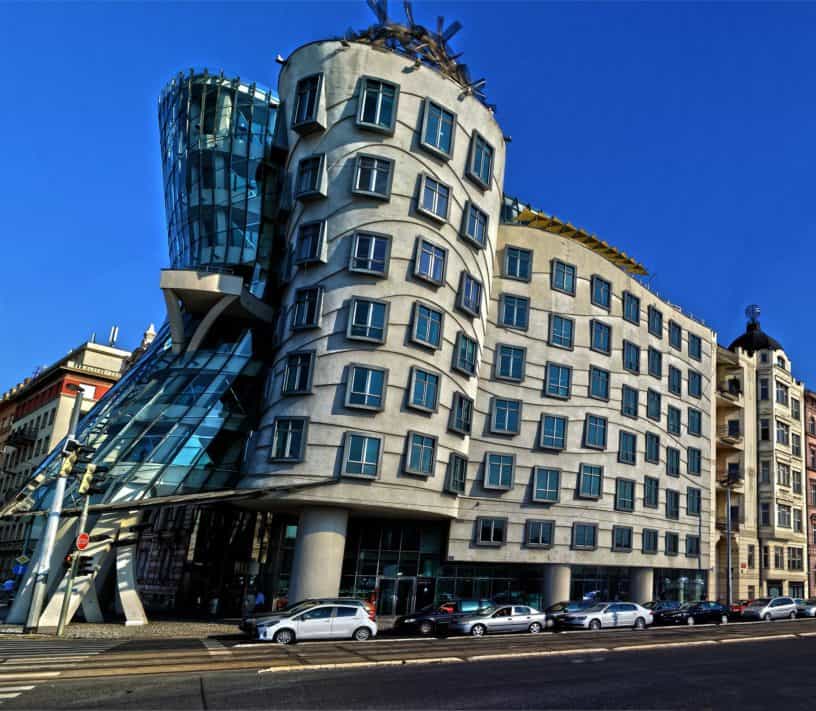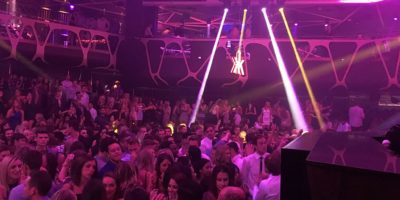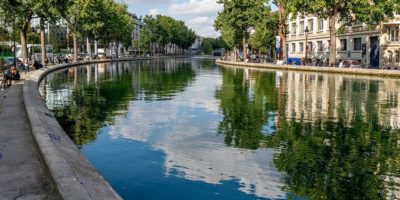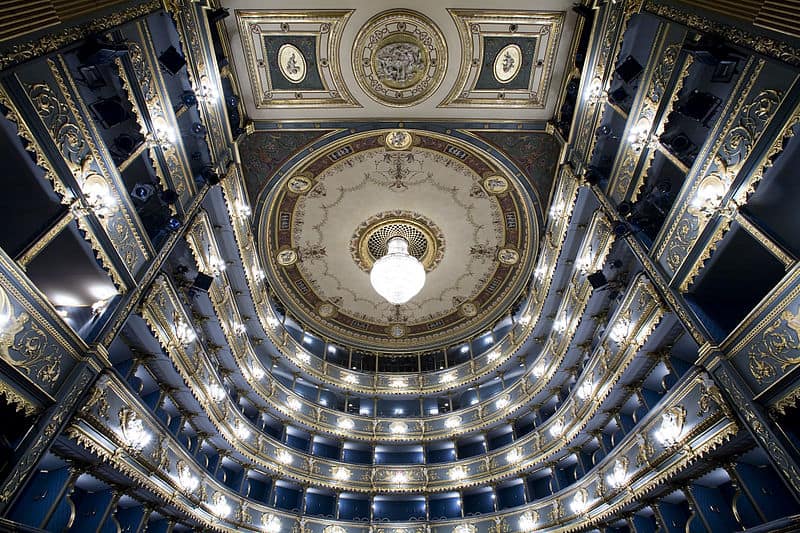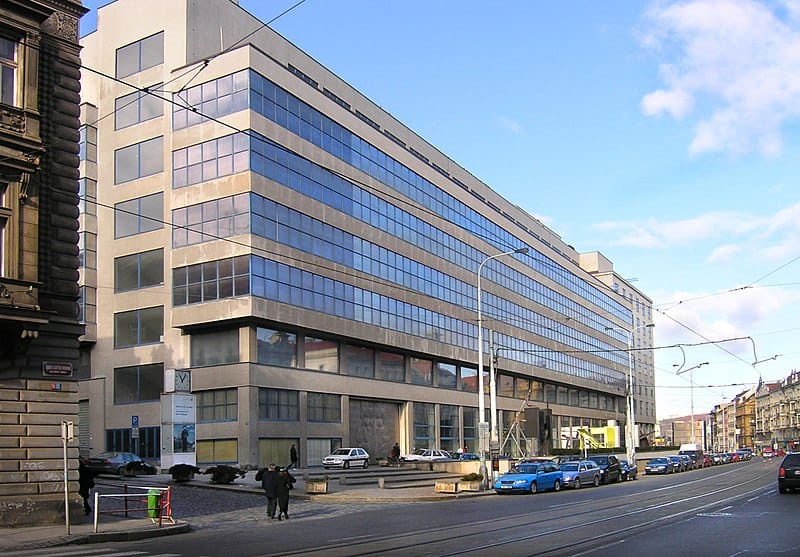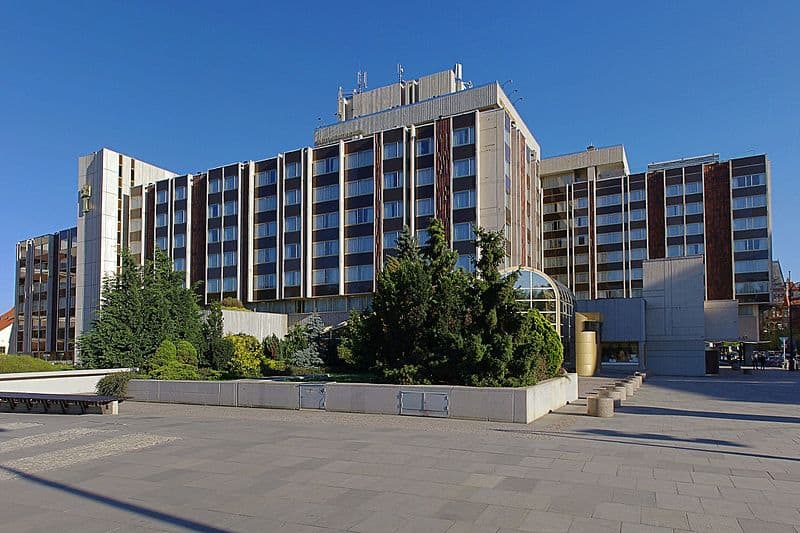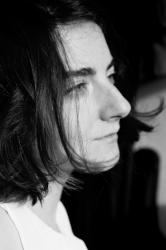A Quick Guide to Prague’s Architecture
Prague is a wonderful destination for all tourists, but achilovers in particular, as Prague offers a variety of different architectural styles all found within close proximity from one another. These include not only the UNESCO sights, but also many other hidden gems.
One of the most amazing surprises lies in the architectural mixture that confuses the travelers throughout their journey. Who would expect an Art Nouveau house built just next to an old medieval gothic gate, opposite which there is a functionalist bank representing the tradition of the 1930’s?
In Prague you can find these eclectic mixes everwhere, especially on the Republic Square (Náměstí Republiky). Just look for The Municipal House (Obecní dům), The Powder Gate (Prašná brána) and The Czech National Bank (Česká Národní banka) building.
There’d be a lot of examples of these mixtures – a classical building opposite a neo-gothic tower of the university that was partly rebuilt in the 1970’s. A cubist building standing next to a row of art-nouveau residential apartments that is suddenly cut by a Brutalist hotel. A renaissance well in the middle of a baroque courtyard. The list is infinite… that’s why I will provide a quick guide to Prague’s architecture in chronological order, so you’d know what to expect when coming to the city.
The Romanesque Art (900-1300)
Rotundas, basilicas, cloisters. Sculptures and illuminations. And many stones; the Romanesque art is a pre-gothic style, typical for Europe of the 10.-13. century. From the Western expressions, the most notable would be the Basilica in Cluny, France. Some beautiful golden objects and Madonnas are known from the Byzantine Orthodox art. And even here in Prague there are still some remains of this era.
You can very simply reach the Prague Castle and search for the Saint George’s basilica (Svatojiřská bazilika).

Saint George Basilica in Prague, image by Prazak sourced from WikimediaCommons
From the front, it might remind you of a typical red and white baroque village church, but don’t let yourself get confused. It is just a baroque façade reconstruction.
The rest of the church is romanesque, since the basilica was built already in 920. To search for a rotunda, go to Konvitská street right in the city center.
Do not miss Rotunda of the Finding of the Holy Cross (Rotunda svatého Kříže) that dates back to the beginning of the 12th century.

Rotunda in Prague, image by VitVit sourced from WikimediaCommons
To time travel back into the present, just step into the café/bar Duende that is nearby. It changes from a coffee place to a cool bar during the evening, and it is a great place packed up with both locals and visitors in the same time.
Gothic Era (1200-1500)
Undoubtedly, the Gothic era was a remarkable age for Prague’s architecture. The two main attractions of Prague are wonderful examples of this style.
The first main atraction is the Charles Bridge, whose construction started on the 9th July at 5.31 am in 1357, and lasted for 60 years.

Charles Bridge Prague, image sourced from Pixabay
Just look at the massive pillars and the towers on each side of the bridge. Yet, pay attention – the statues on the bridge are younger as they date from the baroque era.
The second main attraction of Prague is the St. Vitus Cathedral (Svatovítská katedrála) at the Prague Castle.

Vitus Cathedral in Prague, image by Kirk Fisher sourced from Pixabay
Again, there are some doubts, since the construction started in the 14th century, but was finished in 1928. We’d call it then a Gothic and a neo-Gothic monument mixing two styles in one building.
When approaching the Cathedral, one must say that it is really tall, since that was the goal of most architects from the time – to be close to the sky, to be close to the God.
You can check it out yourself – visit the Cathedral until 4pm in the winter and 5pm in the summer. To see it from the exterior, no need to go inside – the Prague castle complex closes at 22 pm.
To get all the in detail explanations and the best insights, you can also join our Night Castle Tour led by our knowledgeable and local guides.
The tallest church in Prague is Our Lady of the Snows; another tall Gothic church is Our Lady Before Týn (Týnský chrám) right at the Old Town Square.
Yet, Gothic is not always signified by churches.
Right beside the Týn Church, there is the early Gothic Stone Bell House (Dům U Kamenného zvonu).
If wondering about its name, take a look at the right corner and see the bell. Inside, there is now a gallery opened every day except for Monday from 10 am to 8 pm.
The Powder Gate, a remain of a physical border between the Old Town and the New Town, makes a great example of the 15th century art.

The Powder Gate in Prague separating Old Town from New Town, image by A.Savin sourced from WikimediaCommons
However, due to an explosion the roof was reconstructed in a neogothic style. To see a bit of the city, you can also get inside and climb up to see the view.
The opening time varies according to the season (November-February: 10 am-6 pm, March and October: 10 am-8 pm, April-September: 10 am-10 pm). The entry is 100 CZK (EUR 4) for adults. Reduced prize for students or seniors is 70 CZK (EUR 3).
Renaissance (1300-1600)
Unlike in Italy or France, the renaissance architecture in the Czech Republic is not as developed and the Prague city center is much more saturated by gothic or baroque architectonical pieces.
Yet, some renaissance monuments could still be found – notably, the Belvedere in the royal gardens of the Prague Castle.

Belvedere in Royal Gardens, image by Øyvind Holmstad sourced from WikimediaCommons
Close to the Castle, on Hradčanské square, there is the Schwarzenberg palace, a patrimony of an aristocrat family. A bit further from the city center, on the terminus of the tram line 22 (called Vypich), you can also find…
Hvězda – a Star Palace – constructed in a shape of a star and surrounded by a tranquil game reserve.

Star Palace in Prague, image by Letohrádek Hvězda sourced from WikimediaCommons
You can go into the Star Palace from 10 am to 6 pm, except for Monday, when it’s closed. Do not forget to check for the exhibitions, as there is still something going on.
Baroque & rocaille (1600-1700)
In comparison to the spectacular yet modest gothic and romanesque architecture, baroque might seem as an over decorated birthday cake. However, it is also a very common style you can come across when strolling in the Prague city center.
The baroque monuments were constructed mainly during the reign of the Habsburg dynasty, influenced by a catholicization of the Czech lands.
An example of this era is the Saint Nicholas Church (kostel svatého Mikuláše).

The interior of St Nicholas Church in Prague, image by Jorge Royan sourced from WikimediaCommons
More precisely, there are two of them in the city, and both of them are baroque.
However, the one you can find on Malostranské square is considered as the most beautiful baroque monument on the north from the Alpes. With its green cupola, it is already visible whenever we cross the Charles bridge and you can visit it from 9 am to 16 pm, or until 17pm, when it is summer.
The entry is 100 CZK (EUR 4) for adults and 60 CZK (EUR 2.50) for students and pensioners over 65. Kids younger than 10 could get there for free.
Apart from the churches and a great part of the Prague Castle, a notable example of baroque in Prague would definitely be…
Klementinum: a former Jesuit college that offers not only a beautiful library, but also an astronomical tower.

Kementinum, image sourced from the library’s official site
Rocaille, a younger sibling of baroque, is less frequent, however, do not miss the former Jewish Town Hall decorated by clock numbered by Hebrew symbols and turning counterclockwise.
Classicism (1700-1800)
This style, deeply rooted in a tradition of the Roman antiquity is known for its obsession by geometry.
Spot this on the Estates Theatre (Stavovské divadlo) building.
Not only it is a great piece of architecture, it also plays an important role in cultural history. In 1787, Mozart premiered his opera Don Giovanni in the theatre hall, and in 1834, the Czechs could have heard the national anthem for the first time. To see the interiors of the theatre, you can book a spectacle, or, if feeling Prague-sick after your trip, just watch Amadeus by Miloš Forman, since it was shot in the Estate Theatre.
Avant-gardes and art-nouveau (1900-1940)
Twentieth century offered a lot of amazing gems – art nouveau, represented by the residential areas of the Jewish Town or Vinohrady.
The main example would do the Municipal House from 1912, a civic building that houses a concert and an exhibition hall.
Cubism, an architectural rarity known rather from avant-gardist paintings or poetry, is portrayed in the Black Madonna House that dates back to 1912, or in a few more recently built houses below the Vyšehrad hill.
I must admit that the Black Madonna House (Dům U Černé Matky Boží) is also my favorite building in Prague.
I would highly recommend you to climb up to the first floor and relax in the Grand Café Orient. It’s an amazing coffee place with an extraordinary interior.
Another style, often confused with the constructions of the communist era, is called the functionalism. Plain, simple, squared.
Observe functionalist architecture at Trade Fair Palace (Veletržní palác) in Holešovice (47 Dukelských Hrdinů street).
This building, constructed in the late 1920’s, is also filled by important art collections you must not miss. Trade Fair Palace is opened from Tuesday to Sunday from 10 am to 6 pm, and on Wednesday even up to 8 pm. By the way, the ground floor of the building offers a cool coffee place named Café Jedna. To spend some time there is a great way to digest every piece of art.
Under the communist regime (1940’s-1989)
Under the dominance of the communist regime and with the evolution of the brutalist style, the face of Czech architecture slightly changed. Nowadays, these brutal monsters are being destroyed all over the Europe, but, even among them, we can find some pure architectonical beauty. It might not be a love for the first sight, but it is still an architectural work one should respect.
Brusque, concrete, monstrous – just take a look at the Kotva building, a department store constructed in the shape of a multiple hexagons.
Another great example of brutalism is the Hotel Intercontinental.
Both Intercontinental and Kotva were built in the mid-1970’s, which was also the era of the construction of the first metro stations in Prague, some of which still keep their visage from this era – take a look at the vividly colored tunnels!
Postmodern (1990’s-now)
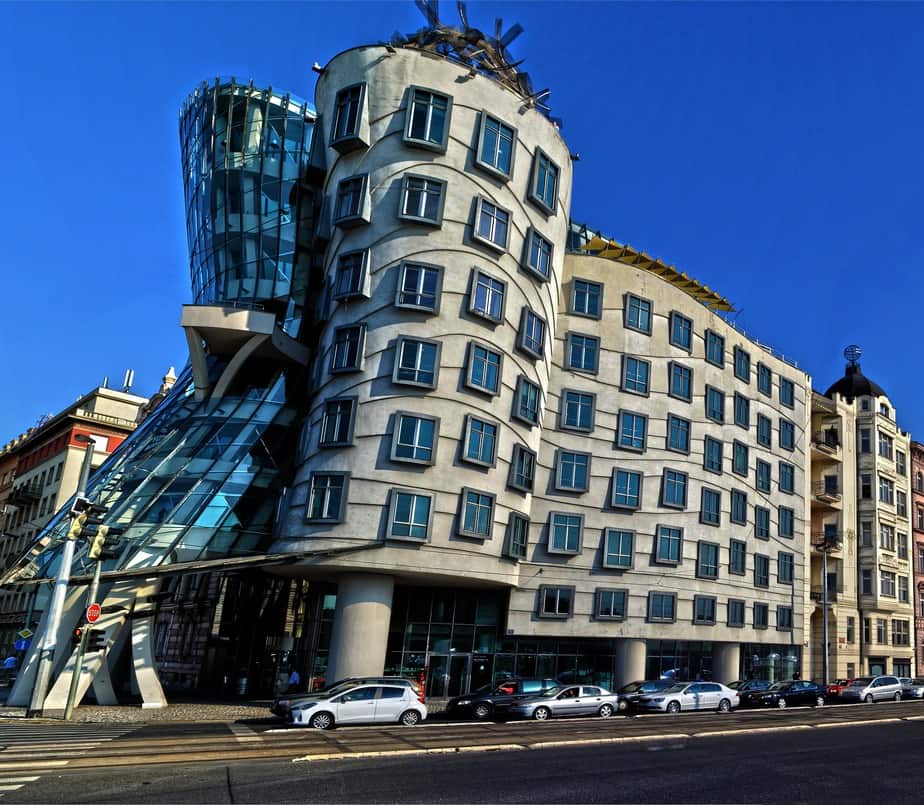
The Dancing House in Prague, image by Lenka Sevcikova sourced from Pixabay
In 1996, the Dancing House (Tančící dům, Rašín Embankment) close to the river Vltava was built.
It was a tribute to the dancing couple of Fred Astaire and Ginger Rogers,
The plans of the building were created by a duo of architects – Vlado Milunić and Frank Gehry – the latter is known for the construction of Fondation Louis Vuitton in Paris, or other constructions in California, USA.
As always, the Czechs think that in the present none interesting construction was built. And as every time, we can prove them wrong. To see a great piece of contemporary architecture, take a metro to the station Dejvická…
Visit the National Technological Library (Národní technická knihovna) building.
It is a leger and a sovereign piece of art with witty interior details that you can observe. Just please, do not disturb the students once you’re there.

National Technological Library, photo by Ilya Rudomilov (www.rudomilov.ru), sourced from WikimediaCommons
Every style has its defenders and opponents – taste for art is a very unstable issue, and that’s why it is important to keep looking around, since it is an essential way to cultivate ourselves. Prague definitely brings a great occasion for this, as it is an important piece of the jigsaw of European architecture.
Planning a trip to Paris ? Get ready !
These are Amazon’s best-selling travel products that you may need for coming to Paris.
Bookstore
- The best travel book : Rick Steves – Paris 2023 – Learn more here
- Fodor’s Paris 2024 – Learn more here
Travel Gear
- Venture Pal Lightweight Backpack – Learn more here
- Samsonite Winfield 2 28″ Luggage – Learn more here
- Swig Savvy’s Stainless Steel Insulated Water Bottle – Learn more here
Check Amazon’s best-seller list for the most popular travel accessories. We sometimes read this list just to find out what new travel products people are buying.

